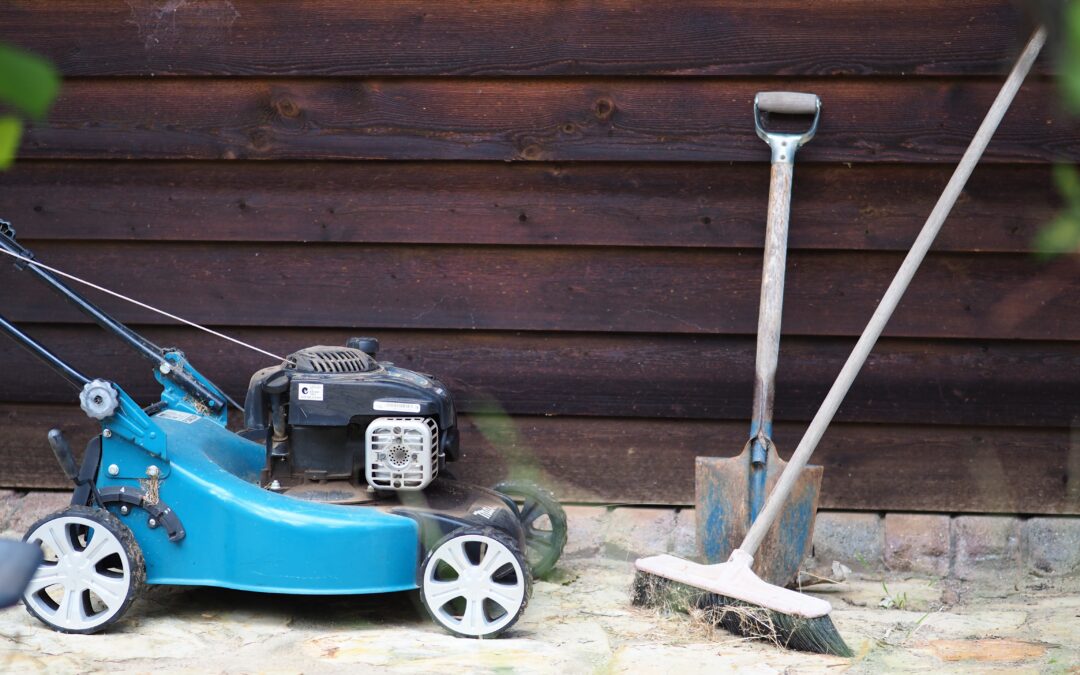Sometimes, your lawnmower just won’t cut the way it used to. In this situation, lawn mower disposal should be high on your to-do list. Once accomplished, however, lawn mower disposal leaves you with one more task — dealing with old mower blades.
What do you do with old lawnmower blades? We’re here to share some clever and original mower blade recycling and disposal tips.
Stay tuned to find out what you can do to your old blades and how to dispose of them properly if recycling isn’t in the cards. We’ll also share the simplest and safest way to remove old lawn mower blades and some answers to the most common questions about blade and lawn mower disposal.
Make Colorful Metal Flowers for Your Garden
You don’t need a green thumb for this one. Because of the shape of your mower blades, you can turn them into metal flowers. Doing this is an original way to add vibrance to your garden.
To turn your old mower blades into metal flowers, you’ll need several items, including paint, brushes, some water, and vinegar.
Begin by soaking your old blades in water with diluted vinegar overnight. This will eliminate residual dirt and rust from your blades. After that, rinse and clean your blades to prepare them for painting. Before you paint, put on a pair of gloves to protect your hands from serrations.
From there, start painting your blades in your desired colors and let them dry. You’ll end up with metal flowers that give your garden an “edgier” look.
Grind the Old Blade Into a Garden Machete
Are you ready to unleash your inner blacksmith? Turn your old rusty mower blade into a handy garden machete.
Turning your blade into a garden machete requires some familiarity with an angle grinder. To kickstart your metalworking project, you’ll need an angle grinder, two pieces of wood you can use as a handle, a drill, sandpaper, and a bench vise.
Begin by securing the blade on a bench vise. After securing the blade, cut and shape the blade using your angle grinder. A beveled shape is advised for added sharpness.
Once you’ve done that, take the newly fashioned blade and refine it with sandpaper. Then, drill some holes in the tang (or bottom) for a handle. The holes will accommodate the screws you need to install for the handle.
Take the two pieces of wood and drill holes in them too. From there, sandwich the blade’s tang or bottom between the two pieces of wood and attach screws into the holes to secure the blade.
Tape the handle for added security, and you’ll have a nifty tool for your gardening tasks.
Forge a Damascus Knife with Several Blades
Do you want to take your blacksmithing to the next level? If so, you can take several blades and craft a Damascus steel knife.
Creating your own Damascus knife requires at least three old blades, a hammer, a forge, an anvil, clamps, tongs, and quenching oil.
To begin making your blade, heat your old mower blades together in your forge. Once they start to warp at the edges, they’ll be ready for you to shape on an anvil. With your hammer, pound on the heated blades until they reach your desired flatness and contour. You can also layer the blades to create intricate patterns.
From there, shape your blades into a knife and heat treat as necessary using quenching oil. Refining your blade’s shape and sharpness will require a grinder.
Attach a handle, and you’ll end up with your very own Damascus knife.
Use the Old Blade for Electrolysis
Your blades may be old and rusty, but there may be hope to restore them. How? You can revitalize them through electrolysis.
Electrolysis is an environmentally sound way of restoring blades. All you need are your old blades, some scrap metal, sodium carbonate (washing soda), and a battery charger. You’ll also need a container for the process.
Start by preparing the electrolysis solution. To do this, you must pour water and sodium carbonate into the container. After that, submerge the blades in the solution.
The next step is to hook your old blades and the scrap metal to the battery charger. This will start the electrolysis process.
In just moments, you’ll see the rust on your old mower blades transfer to the scrap metal. Once the scrap metal becomes rusty, you can disconnect the battery charger and remove any dust or debris from your old blades.
Take the Blades to a Scrap Yard
Sometimes, your old blades are beyond restoration. In that case, the only option left is the scrap yard.
Taking your blades to the scrap yard is a straightforward process. However, before you load up your old mower blades and haul them off, contact your local scrap yard. Often, scrap yards have restrictions or rules governing the types of metal blades they receive.
Safety First: How To Remove Old Lawn Mower Blades
We’ve just gone over how you can dispose of, repurpose, and revitalize your old mower blades. However, before you can do anything with your blades, you need to remove them safely.
Follow these steps for safe lawn mower blade removal:
- Secure your lawnmower to prevent accidental movement.
- Disconnect your lawnmower’s spark plugs to prevent accidental starts.
- Wear safety gloves and goggles.
- Inspect your blades and remove them using tools like a socket wrench.
MowTown Blades: When Reusing and Recycling Just Won’t Cut It
Sure, it’s always environmentally sound to reuse and recycle. However, if you need new blades, there’s only one place to get them from — MowTown Blades.
MowTown Blades offers the best high-quality blades for all types of lawnmowers. Choose blades that are a cut above the rest. Check out our catalog and mow like a pro!
FAQs
What Pieces of Safety Equipment Should I Have During Blade or Lawn Mower Disposal?
At the very least, you should have the following:
- Safety goggles
- A first-aid kit
- Thick safety gloves
What Types of Scrap Metal Should I Have for Electrolysis Restoration?
The best metals to use as scraps are steel and iron.
Besides Vinegar and Water, What’s Another Solution for Rust Removal?
Vinegar and water are readily available agents for removing rust. However, if you prefer a ready-made chemical for the task, consider WD-40 and other commercial rust removers.

